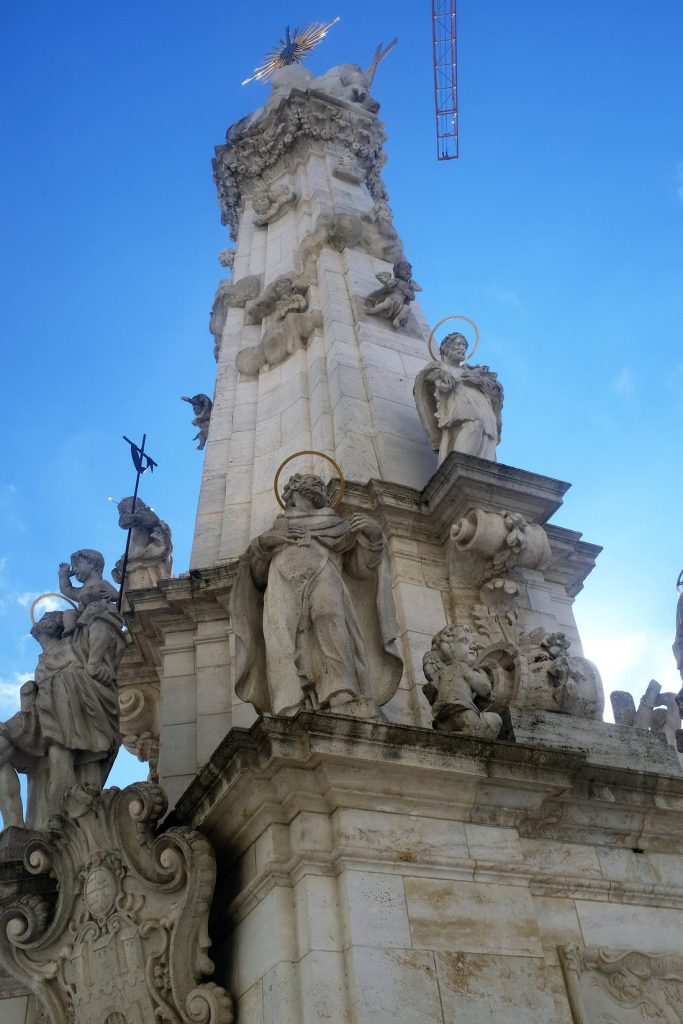Holy Trinity Column: Budapest’s Symbol of Faith
Perched prominently in front of the majestic Mátyás-templom (Matthias Church) is the baroque-style Holy Trinity Column. With its foundation made from solid stone blocks and adorned with exquisite statues and reliefs, this monument commands attention and admiration from all who visit.
Location and History
The Heart of the Castle District
Nestled in the heart of Budapest’s historic Castle District, the Holy Trinity Column stands in Szentháromság tér (Holy Trinity Square), forming a central part of this area’s charm and historical significance. The Castle District, a UNESCO World Heritage site, is a maze of narrow streets and medieval buildings transporting visitors back in time. The square where the Holy Trinity Column resides was once densely packed with houses, streets, and alleyways. However, the siege of 1686, which liberated Buda from Ottoman rule, left much of the area in ruins. The devastation led to the creation of the expansive square we see today.
A Monument Born of Plague
In the aftermath of the plague outbreaks that ravaged Europe, including Hungary, the city council of Buda commissioned a column dedicated to the Holy Trinity. This column was both a plea for divine intervention to end the plague and a symbol of gratitude for its eventual cessation. The original column, erected in 1695, was replaced by the current, more elaborate, and grandiose Holy Trinity Column between 1710 and 1713. This replacement was partly due to the belief that a more impressive monument would offer better protection against further outbreaks.
Architectural Highlights
A Baroque Masterpiece
The Holy Trinity Column isn’t just a historical marker; it’s an architectural marvel. Standing at a towering 15 meters, this hexagonal obelisk is crafted from limestone, a material that has weathered the centuries with grace. The column is richly adorned with statues and reliefs, ranging in height from 1.8 to 2.8 meters, each meticulously detailed and expressive.
Intricate Reliefs
As you gaze upon the statue, you’ll notice three intricate reliefs that adorn its surface:
- King David’s Plea: This relief depicts King David imploring to end the plague, his posture and expression conveying desperation and hope.
- The Plague Scene: This relief, which features the Buda Castle as the backdrop, harrowingly represents the plague epidemic and illustrates the widespread impact of the disease on the city.
- The Building of the Holy Trinity Memorial: Crafted by artists Ungleich Fülöp and Hörger Antal, this relief details the construction of the memorial you’re admiring, offering a glimpse into its creators’ dedication and craftsmanship.
Artistic and Religious Symbolism
At the top of the column, the Holy Trinity is depicted, with the Father, the Son, and the Holy Spirit represented in traditional Christian iconography. Angels and saints surround the column, further emphasizing its religious significance. The detailed carvings and statues reflect the baroque style’s emphasis on movement, emotion, and grandeur.
A Living Monument
The Evolution of Szentháromság tér
Over the centuries, the square surrounding the Holy Trinity Column has undergone several transformations and name changes, reflecting the region’s dynamic history. Today, Szentháromság tér is a testament to Budapest’s resilience and enduring spirit. The Holy Trinity Column remains a focal point for locals and tourists, where history, art, and faith converge.
Reflections of Resilience
Visitors to the Holy Trinity Column are invited to reflect on the resilience and hopes of those who once faced the plague’s wrath. The monument is a powerful reminder of the community’s faith and determination in the face of unimaginable hardship. It stands as a relic of the past and a symbol of enduring hope and communal strength.
Tourist Tips
Exploring Szentháromság tér
While visiting the Holy Trinity Column, please take a moment to soak in its intricate details and the rich history it represents. Reflect on the resilience of those who faced the plague and the faith that inspired this beautiful monument.
Matthias Church and Beyond
Behind the Holy Trinity Column stands the stunning Matthias Church, one of Budapest’s most iconic landmarks. The juxtaposition of these two structures encapsulates the city’s rich history and architectural grandeur. With its colorful tiled roof and intricate Gothic spires, Matthias Church offers guided tours that dive into its storied past.
Discover the Castle District
Don’t forget to explore the broader Castle District area. This historic quarter is home to several museums, the Buda Castle, and charming streets filled with cafes, shops, and historic buildings. Each corner of the Castle District tells a story, contributing to a comprehensive understanding of Budapest’s glorious past.
Conclusion
The Holy Trinity Column in Budapest is more than just a monument; it symbolizes faith, resilience, and artistic achievement. Located in the historic Castle District, visitors can connect with Hungary’s rich history and cultural heritage. Whether you’re a history buff, an art enthusiast, or simply seeking inspiration, the Holy Trinity Column and its surroundings provide a profound and memorable experience.
